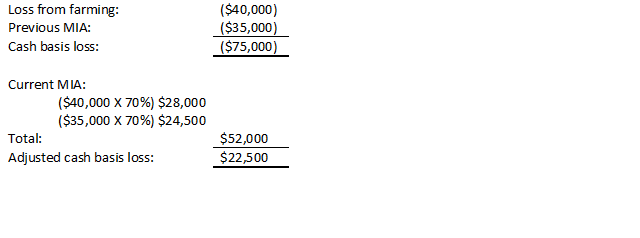| | Full-time Farmer | Hobby Farmer | Part-time Farmer or Restricted Farming Losses | Mandatory Inventory Adjustment (MIA) | Optional Inventory Adjustment | Restricted Farm Losses | Creating a Loss with Specified Animals
.
Regardless of what type of farming activity individuals undertake, they are only allowed to write off losses for tax purposes if they are engaged in the business with a reasonable expectation of profit. The income tax act classifies people engaged in farming in three different categories. The principal difference among these groups is the extent to which they can deduct losses relating to their farm activities.
Full-time Farmer
An individual whose chief source of income is farming is considered a full-time farmer. Such individuals are allowed to treat their farming business like any other business. As a result, they can claim losses against other income for tax purposes if they suffer losses in any given year.
Hobby Farmer
Those individuals who do not have a reasonable expectation of profit from their farming activity are referred to as hobby farmers. Hobby farmers cannot deduct losses from their farm activity at all.
Part-time Farmer or Restricted Farming Losses
Farmers who have a reasonable expectation of profit but whose “chief source of income” is neither farming nor a combination of farming and some other source of income are restricted in the amount of loss they can deduct.
Tips and Traps
Mandatory Inventory Adjustment (MIA)
- In the year that a cash loss occurs, the farmer is required to decrease the loss to the extent that inventory was purchased and is still on hand at the end of the year. The adjustment to the loss is referred to as the Mandatory Inventory Adjustment (MIA) and is a required adjustment that will be applied to purchased inventory only in a loss year.
- The amount of the MIA will be the lesser of:
1. the net farm loss calculated on a cash basis (including recaptured depreciation and capital cost allowance) and
2. the value of purchased inventory on hand at year end (valued at the lower of cost or market value) unless Specified Animal rules apply.
Optional Inventory Adjustment
- Farmers operating on a cash basis may include in their income for a year any amount up to the fair market value of their inventories on hand at the end of the year. In the subsequent year, a deduction equal to the optional inventory added in the previous year is made.
- An optional inventory adjustment should be considered in a very low income year providing you can determine that the following year farm income will be substantially higher. The adjustment could reduce the amount of income that would be subject to a higher rate tax.
Restricted Farm Losses
- For farmers with a reasonable expectation of profit but whose chief source of income is not farming, the use of their losses against other income is restricted. The loss allowed is $2,500 plus one half times (your net farm loss minus $2,500) to a maximum of $17, 500. The portion of the loss not deductible currently under this restriction is available for carry-forward and can be used in the future against any farm income (20 year carry-forward). It could be carried back to reduce farm income reported in any of the three previous years.
- Mandatory Inventory Adjustment (MIA) must be calculated before claiming a loss or a restricted farm loss
Creating a Loss with Specified Animals
- In general, a farmer will be denied a loss attributable to purchases of inventory (see Mandatory Inventory Adjustment). However, for horses and certain registered bovine animals, a portion of the loss may be deducted. (Note: bovine is not a zoological term; it implies cattle and oxen.)
- For the purposes of the mandatory inventory adjustment, inventory is generally valued at the lower of cost or fair market value; however, the taxpayer may elect to value "specified animals" on a diminishing balance basis.
- A farmer may choose to value a "specified animal" at 70 per cent of the total of its cash cost or at a greater amount not exceeding its cash cost. For a year subsequent to its acquisition, the animal may be valued at 70 per cent of the total value determined at the end of the preceding year or at a greater amount not to exceed its cash cost.
For example:
Assume the only transaction in the year was the purchase of registered bovine animals for $50,000.
The cash basis loss for the farm business would be $50,000. Under the mandatory inventory adjustment (MIA), the add-back required for tax purposes would be $35,000, resulting in a $15,000 loss for tax purposes that could be used to offset other income.
(Note: depending on specific circumstances, it is possible this loss could be subject to restricted farming losses as discussed in the Farm Losses section.)
| Loss from farming | ($50,000) |
| MIA ($50,000 X 70%) | $35,000 |
| Loss from farming | ($15,000) |
For the second year, therefore, a $22,500 loss would exist that could be used against other income (also possibly subject to restrictions discussed in the Farm Losses section).
(Note: this assumes a reasonable expectation of profit exists for the operation.)

|
|